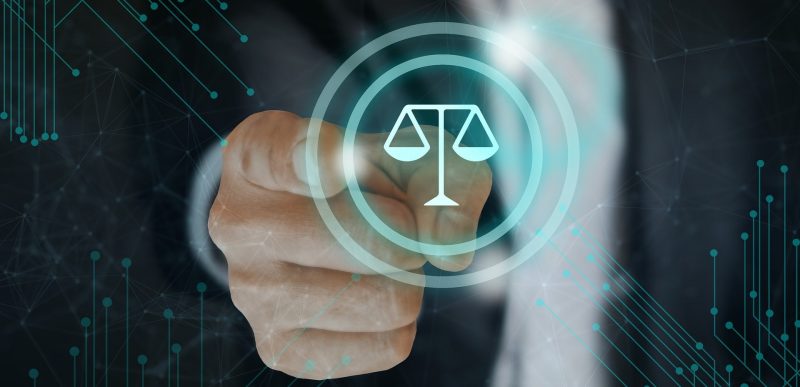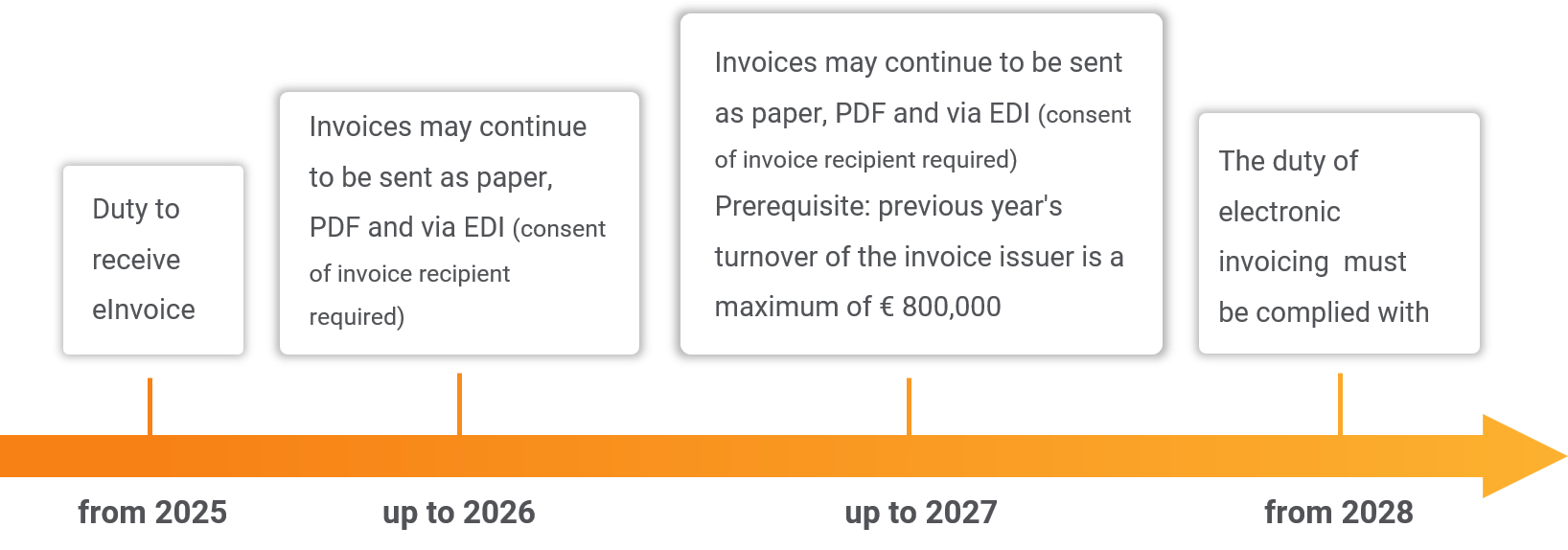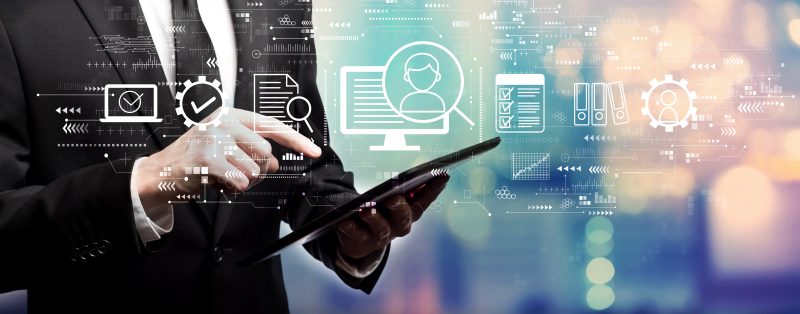The Electronic Invoicing Obligation is Coming: Processing E-invoices in the SAP System

Until now, the obligation to use electronic invoices (e-invoices) only applied to public contracts. This will change on 01.01.2025 with the introduction of the so-called e-invoicing obligation for all German companies in the B2B sector. This decision is regulated in the Growth Opportunities Act, which was passed by the Bundestag on 17.11.2023 and finally approved by the Bundesrat on 22.02.2024. Specifically, this means that all companies based in Germany are obliged to be able to receive and process invoices electronically.
But what exactly is an eInvoice, what advantages do eInvoices offer and what is needed to process them in the existing SAP system? We will inform you about the topic and answer all relevant questions that need to be clarified.
Why is the Processing of E-invoices Mandatory?
The requirement to process invoices electronically in future is based on the VIDA measures, which are to be implemented throughout the EU. VIDA stands for "VAT in the Digital Age" and is an initiative of the European Commission that aims to modernize the VAT system. The aim is to make trade within the EU more transparent and more secure against fraud. The use of digitalization and standardization of the invoice format increases traceability and security. For this reason, electronic invoices are to become the leading method of invoicing.
To Whom Does the E-invoicing Obligation Apply?
As mentioned at the beginning, the e-invoicing obligation previously only applied to public contracting authorities. The EU Directive (2014/55/EU) obliges all federal administration authorities, federal constitutional bodies, federal states and municipalities to be able to receive and process electronic invoices. This regulation has now been adopted for all German companies in the B2B sector. The decisive factor here is the registered office of the companies involved in the turnover. The e-invoicing obligation applies as soon as the company headquarters, a branch or the management is based in Germany. A place of residence or habitual abode in Germany also makes e-invoicing mandatory (Section 14 (2) sentence 3 UStG-E).
There are exceptions, e.g. for small amounts (Section 33 UStDV). Invoices with a value of less than €250 are not subject to the e-invoicing obligation and may continue to be sent in paper form, PDF etc.
Is there a Timely Step-By-Step Plan for Implementation?
Initially, the obligation relates to the receipt of e-invoices. In other words, from 01.01.2025, all companies must ensure that they are able to receive electronic invoices. For those who already process their invoices digitally or use an ERP system such as SAP, this can be implemented quickly and cost-effectively. More on this in the rest of the text.
From 2028, the obligation to use e-invoices will also apply to shipping. As this changeover involves more effort and requires resources, the following step-by-step plan for the implementation of the e-invoicing obligation is currently available:
From 01.01.2025: It must be possible to receive electronic invoices.
Until the end of 2026: Paper invoices, PDFs or invoices that do not comply with the eRechnngs format may continue to be transmitted. This applies to transactions carried out in 2025 and 2026 and requires the consent of the invoice recipient.
Until the end of 2027: Paper invoices and invoices that do not comply with the e-invoice format may also continue to be transmitted for sales carried out in 2027. An additional requirement is that the previous year's turnover of the invoice issuer does not exceed €800,000.
From 2028: The e-invoicing obligation and all associated requirements must be complied with.

What is an eInvoice?
Not every digital invoice is also an e-invoice. A PDF that is received by the company via e-mail , for example, does not count as such. The reason for this is that a PDF is merely a digital, pictorial invoice and does not enable direct electronic processing.
An eInvoice, on the other hand, always contains a structured data record that is required for digital invoice processing without media discontinuity. The classic format for this is XML and looks like this, for example:

An invoice that is transmitted in XML format is a so-called X-invoice. There are also ZUGFeRD invoices that contain both the invoice image, e.g. in PDF format, and the structured invoice data in XML format.
Another way to process invoices electronically is via EDI. EDI stands for "Electronic Data Interchange" and, as the name suggests, this involves the electronic exchange of documents between business partners. In our context, this would be the electronic exchange of invoices between two SAP systems.
Important: When exchanging invoices electronically via EDI, certain factors must be met for this procedure to be permitted. Certain information is required for VAT, which must be extracted correctly and completely from the format used. The result must comply or be compatible with the CEN standard EN 16931. Our product maxflow® interface EDI fulfills all the necessary requirements and is therefore ideally suited for the EDI process between SAP systems.
In summary, the X-bill, the ZUGFeRD format and transmission via EDI fulfill the requirements of the e-invoicing obligation.
What Advantages do Electronic Invoices Offer Companies?
Digitization has picked up speed in recent years and is showing its progress particularly in document processing. The aim is to make work processes more efficient, minimize processing times, create transparency and replace paper-based processes in the interests of sustainability. The success of this is immense and products such as our invoice workflow maxflow® invoice management have refined and optimized digital invoice processing in numerous ways.
While the data from paper invoices and PDF invoices must be read with the help of document reading (OCR), structured data records can be processed directly. Even though the recognition rate of OCR is now very high, e-invoices deliver the highest accuracy. Errors are reduced by the media break-free and automated processing, which in turn improves the quality of the data. In addition, manual intervention in the process is minimized enormously.
In practice, this means that if all German companies process invoices among themselves in eInvoice format in future, this will result in enormous efficiency in the work steps and therefore significant cost savings. Incidentally, the use of eInvoices is much more advanced in other European countries than in Germany. This results in a further advantage, as the processing of invoices that are often complicated or deviate from German conformity is considerably improved.
Beck IT: Specialists for Digital Invoice Processing in SAP with maxflow®
There is still enough time to send e-invoices thanks to the current phased plan. What needs to be implemented first, however, is receipt, as this must be made mandatory in the coming year.
Our maxflow® products cover everything that is necessary for the smooth, digital processing of incoming invoices in SAP. For more information on our product portfolio, please click on the following link: Flexible workflow solutions for SAP
We offer our solutions maxflow® interface eRechnung and maxflow® interface EDI for processing eInvoices. The structured data from the eInvoices is received directly by our SAP interface maxflow® interface and an SAP document is generated from it. Our products are SAP-integrated, certified and comply with all eInvoice requirements. We would be happy to advise you on your individual implementation strategy on the way to digital, secure and transparent invoice processing. Arrange a free consultation using the contact form: We will be happy to advise you! - Contact Beck IT
Sources:
Electronic invoicing becomes mandatory: E-invoicing at a glance | Taxes | Haufe
From 2025: E-invoicing becomes mandatory (handwerksblatt.de)

